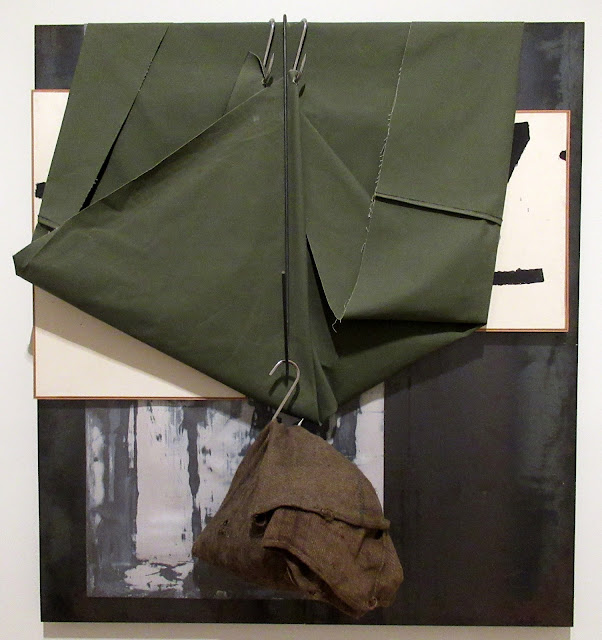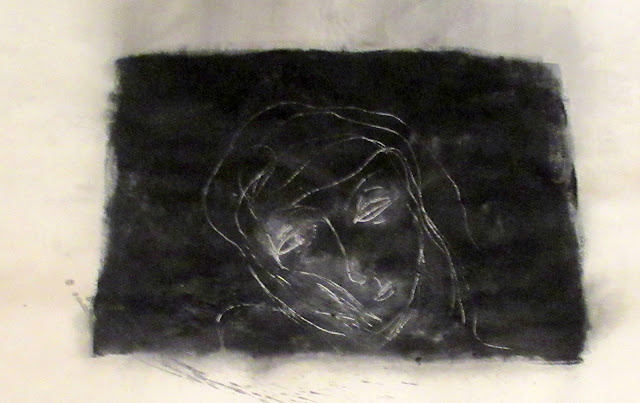Yannis Kounellis at Tate Modern.
Untitled, 1960-98, (steel panel, enamel on paper on 2 canvases, fabric, coal, 3 metal hoods and metal rod)
In this work, the artist hangs two fragments of drawings from the early 60s near the top of a steel panel. Kounellis often utilises metal sheets as blank backdrops or 'sheets of paper', on which he assembles his images. The two drawings on canvas are partially covered by a sheet of tarpaulin, while a sack of coal hangs from as metal rod. The composition draws attention to the physical properties of these objects, like the weight, gesture and pliability. Kounellis' use of these ordinary materials reflects the ambitions of Arte Povera aiming to unite art with everyday experience.
Untitled (Sack with Z), 2001 (steel, burlap sack, coal, paint and glass)
From 1989 to 2005 Kounellis made a series of boxes, produced in many ideantical copies, incorporating recurring elements from his past works. The stencilled letter Z on the sack resembles the letters, numbers and symbols of his early 'alphabet paintings'. The sack of coal in this work might allude to trade and commerce, recalling the artist's place of birth, Piraeus, the busy port city near Athens. Kounellis considered steel sheets as a kind of canvas of paper and his assemblages of real materials as paintings, 'because painting is the construction of images and doesn't refer to a ... technique'.
Untitled, 1960, (polyvinyl acetate paint and tempera on canvas)
Untitled, 1993, (steel bedsprings, metal hook and paint on wall)
A recurring element in Kounellis' work since the 1960s, the bedframe symbolises the measurements of the human body and how this shapes our living environment. A real bedframe, suspended from a meat hook, contrasts with the flat, yellow, painted square behind it. Its shape refers to one of the earliest works of geometric abstraction, Kasimir Malevich's Black Square, 1915. Kounellis often connected the colour yellow to the sunflowers and suns in Van Gogh's paintings, as well as to the gold background of religious icons. The work may be a dialogue between reality and abstraction, or between materiality and spirituality.
'I have seen the sacred in the common object. I have believed in weight as the right measure... I want the return of poetry by all means available: through practice, observation, solitude; through language, image and insurrection'. (1987)
Bells, 1993, (bronze bells, wooden beams, rope)
Kounellis was interested in the significant presence of church bells in the everyday life of Southern European communities. When this work was first displayed in Pistoia, Italy, the city's Romanesque cathedral was visible from the gallery windows. The artwork's hanging bells visually echoed those in the cathedral's tower, creating a dialogue between its solemn architecture and the sculpture's simple, raw materials. Tethered to the beams, Kounellis' bells are now silent, but they also hold the potential to ring again. 'Bells represent language, a magnified human voice - and the enthusiastic roar of liberation'.
Coal Sculpture with Wall of Coloured Glass, 1999, (glass, steel, coal and paraffin lamp)
According to Kounellis, coal and iron are 'the materials that best evoke the world of industrial revolution'. The paraffin lamp alludes to the process of ore mining. Many of the suspended glass lumps appear to be natural: like coal, glass can form over millenia through the heat and movement of the earth. Both coal and glass speak of the encounter between geological process and human industry. Kounellis considered all his works to be subject to change and often adapted them to different contexts or architectural settings. He made this installation in 2005 by combining two separate works.
'I cannot separate the use of such a mass of coal from the dramaturgy which puts humanity at the forefront. The human being as protagonist of a social drama, of a suffering and marginalised humanity, the human being as a protagonist, with his body and gestures, of an epic which inhabits my imagination'.
Untitled, 1969, (stone)
Every time this work is displayed it's always installed in a doorway, performing the same physical 'blockage' of the threshold. The artist's instructions are to use stones that are sourced locally from the place where the work is exhibited. The wall is executed in a simple masonry style using blocks of irregular sizes, often seen in farmland walls, and appears out of place in a gallery interior. The work may also allude to the blocked doors and windows of abandoned houses, heightening its suggestion of exclusion and threat.
Untitled, 1969, (burlap, chickpeas, coffee beans, green lentils, green peas, kidney beans, white beans and maize)
Untitled, 1979, (charcoal, paper, arrows and stuffed birds)
The outline of an imaginary 19th century townscape and smoking factory chimney may symbolise the rise of industrialisation. Two birds pierced by arrows, a jackdaw and a hooded crow, suggest that this was a violent and traumatic change. The chimney evokes the combustion process that produces the charcoal used to draw it: a process both creative and destructive. The birds were part of the original work made by Kounellis in 1979, the charcoal drawing is remade each time the work is shown.
The five works on paper depict women's heads and loandscapes, also etched into thick and soot-like layer of charcoal. Kounellis compared these to images traced on a water surface: fleeting memories of people and places destined to disappear.
Untitled (Hanging Knife), 1991, (steel, knife, metal hook, etching on paper and glass)
Kounellis used knives in many of his works, often suspended or facing out towards the viewer in a way that suggests impending threat or violence. Here a single butcher's knive hangs from a meat hook over an etching featuring a hand-drawn circular motif. The spiralling lines evoke an energetic scrawling gesture. This hints at a similarity between the knife and the pencil: both are pointed instruments capable of leaving marks. The familiar and pristine appearance of the hanging blade, contrasting with the chaotic scribbled lines, only heightens the atmosphere of suspense and potential menace.



















No comments:
Post a Comment